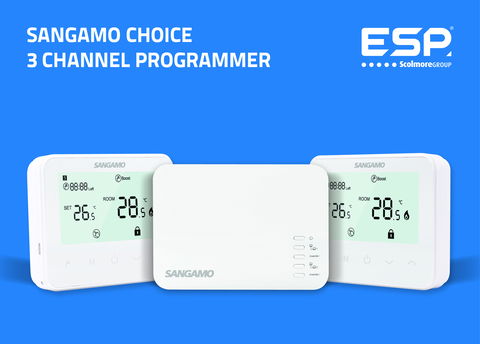With the energy price cap having risen around 10% for a typical home from 1st October this year, the average annual dual-fuel energy bill for households across Great Britain will rise to £1,717 a year, up £149 from its current level. Matt Parton, Product Development Manager with ESP and Sangamo, looks at zone controlled heating as a means of conserving energy consumption.

With energy efficiency top of the agenda for homeowners, the ability to operate and control separate heating zones within a residential property is a way of increasing efficiency and reducing energy use and utility costs.
Traditionally UK heating systems and controls typically mean that the whole property will be heated when a call for heat is made from the system’s thermostat. For a certain size of property, however, heating is only required on one floor of a property or another at a given time, dependent on the occupant’s routines. Therefore, heating the whole property based on one thermostat is not efficient.
Modern day heating systems for certain sizes of properties are now encouraged to have separated heating zones controlled independently in order to increase efficiency and reduce utility cost. For new builds, regulations are set-out specifically for system requirements. In essence heating systems should have the flexibility to only heat the property when and where it is required. For example, for the ground floor living zone the heating will be on during the day and off at night, whilst for a first floor bedroom zone the heating for the bedrooms will be off during the day but operational at night.
Part L
The Building Regulations which cover the energy performance of new and existing buildings have been subject to change in recent years with the approval of Part L (or Document L). Part L Building Regulations is a set of requirements that focus on the energy efficiency of buildings in the UK. It outlines the minimum standards for insulation, heating systems, and overall energy performance. These regulations aim to reduce the carbon footprint of buildings, promote the use of renewable energy, and ultimately enhance the sustainability of the construction industry.
The new regulations officially came into effect on 15 June 2022 and require higher performance targets on all residential property builds and extensions, with further, more stringent regulations due to follow in 2025 as part of the government's Future Home Standard. Part L of the Building Regulations states that ‘for wet heating systems in new dwellings with a floor area of 150m2 or greater, a minimum of two independently controlled heating circuits should be provided.’
Programmable thermostat
A programmable thermostat is one way of controlling and operating separate heating zones in a property and the Sangamo three channel programmable thermostat kit is suitable for properties with two-zoned heating systems and is designed to help installers comply with the requirements of Part L Building Regulations where two zone heating is stipulated. The kit comprises two RF programmable room thermostats to control heating for two zones and the control of hot water, and the supplied receiver which is complete with three independent channels – two for heating zones and one for hot water. The system can be programmed and controlled directly or remotely via the ClickSmart+ app.
One of the main features which supports the thermostat’s energy efficiency lies within the scheduling capabilities. When a call for heat or hot water is made, it requires it to be within a specific time and a specific temperature. This is in comparison to a manual thermostat which is left on the set temperature constantly. Up to six on and off periods per day can be programmed. Another key energy efficiency feature is the OWD (Open Window Detection) function. This is enabled in the parameter settings and uses sudden changes in temperature or humidity to detect if a window is open and switches off the heating until the window is closed to save energy.
Easy installation and ease of programming and operation makes these an ideal solution for installers. The thermostats control the receiver via radio frequency, so there is no need for cable runs, and they can be powered either by replaceable batteries or USB-C power source.
With energy prices already around 50% higher than they were before the energy crisis began three years ago, this winter will be a challenging time for many households. Zone control is a relatively simple concept and one that installers can advise on and easily create for their customers.
The Sangamo range of specialist time switches and heating controls is distributed through Scolmore Group company, ESP.